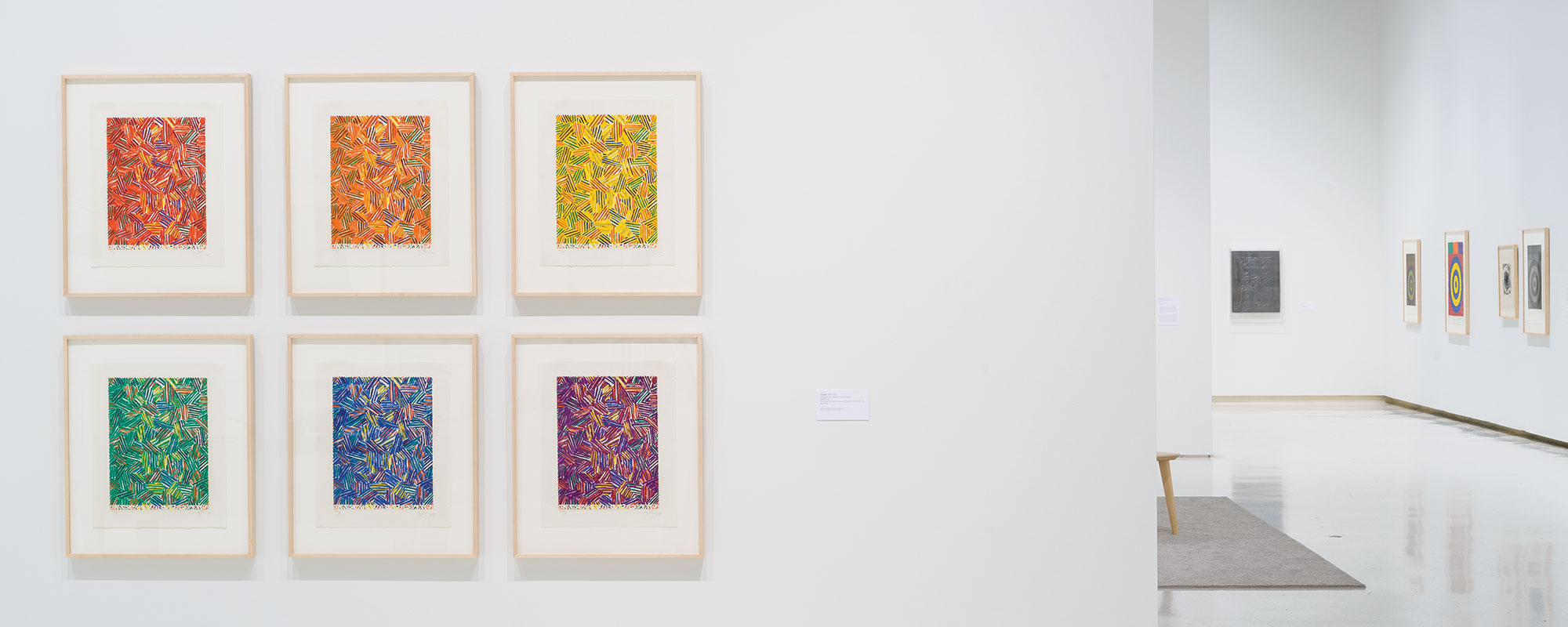You May Also Like
Visions for a Better World The Consummate Friend and Volunteer Creating Belonging Through ArtThroughout his six-decades-long career, Jasper Johns has never stopped reimagining, reconfiguring, and redefining his work. Not too bad for a guy, now 89, who once famously said, “I assumed that everything would lead to complete failure, but I decided that didn’t matter—that would be my life.”
Today, he’s widely considered one of the most influential American artists. “Johns’ work is always migrating across different mediums, from paintings to objects to printmaking,” says Eric Crosby, The Henry J. Heinz II Acting Director of Carnegie Museum of Art and its Richard Armstrong Senior Curator of Modern and Contemporary Art. “His practice has always represented a very contemporary state of mind.”
Exploring that mindset, and how it informs the legendary artist’s printmaking, is the catalyst behind An Art of Changes: Jasper Johns Prints, 1960–2018. Organized by the Walker Art Center in Minneapolis, the career survey made its debut at Carnegie Museum of Art this past October and continues through January 20, 2020.
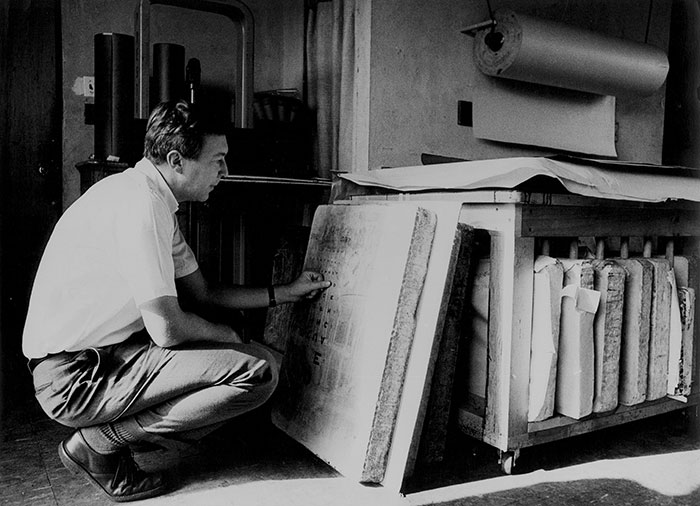
Jasper Johns, 1966, Courtesy Universal Limited Art Editions. Photo: Hans Namuth
“By seeing his prints over the course of decades, viewers are able to understand Johns’ method of returning to motifs he finds intriguing or interesting, and reworking them in different ways,” says Joan Rothfuss, the exhibition’s curator. “Some of his strategies include changing scale, color, or print medium, and fragmenting, doubling, and mirroring the imagery.”
When viewed in its entirety, the trajectory and ever-increasing complexity of Johns’ work is pretty mind blowing. “It’s like the Big Bang,” Crosby says. “It’s this radical expansion and swirling of imagery that comes into Johns’ consciousness. It’s an endless puzzle to unpack.”
Most of the puzzle pieces come by way of the Walker’s unrivaled collection of Johns’ prints, which date back to his early days as an artist. The Walker acquired all of his existing prints in 1988 and arranged for Johns to send the museum a copy of every new print he made going forward. The Walker is now home to some 350 of Johns’ prints, nearly half of which were created since 1988.
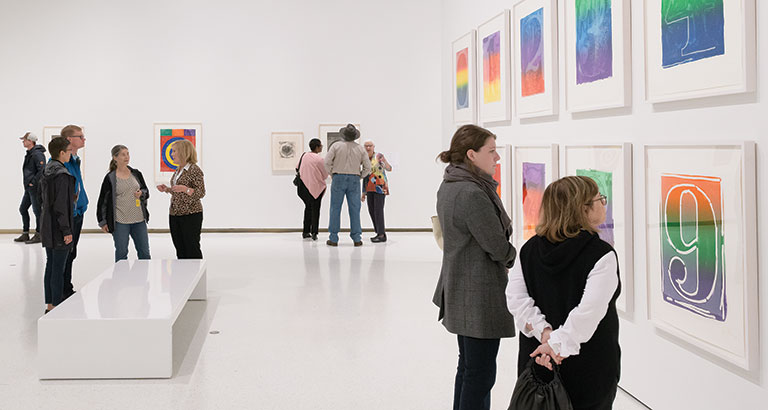
“It’s like the Big Bang. It’s this radical expansion and swirling of imagery that comes into Johns’ consciousness. It’s an endless puzzle to unpack.”
– Eric Crosby, The Henry J. Heinz II Acting Director of Carnegie Museum of Art
Featuring 90 of these works—including examples of his iconic flags and targets—plus several additions from Carnegie Museum of Art’s holdings, An Art of Changes highlights the artist’s command of a wide range of printmaking techniques: intaglio, lithography, woodcut, linoleum cut, screen printing, and lead relief.
“It’s one thing to see a single print, but to be immersed in Johns’ world and in his way of thinking is invaluable,” Crosby says. “The exhibition is not only a master class in Johns’ work but also in postwar and contemporary art, visual creativity, and the role of imagery in our lives.”
The new from the familiar
Rothfuss has long been enthralled with Johns’ art—both the product and the process. “I’ve always been curious about how artists imbue their work with meaning,” she says. “What kind of mark do they make, what kind of materials do they use, how do they approach the image? That’s been Johns’ focus throughout his career. It’s fascinating to watch where he goes.”
Visitors can go along for the ride as the exhibition takes them on a roughly chronological journey through the artist’s printmaking. The first stop may seem familiar because Johns takes symbols or “things the mind already knows”—such as his famous flags, as well as targets, letters, and numbers—and asks viewers to look at them again for the first time.
Moving from symbols to objects, Johns turned to items found in his own studio as muses. The exhibition features, for example, six lithographs titled Savarin (1977–1981)—the name on the coffee can holding a bunch of paintbrushes and other tools of the artist’s trade.
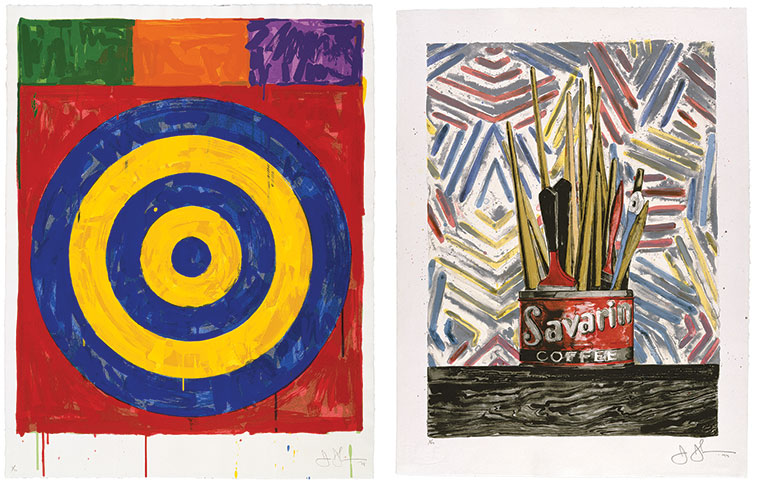
Left: Jasper Johns, Target, 1974, Collection Walker Art Center, Gift of Judy and Kenneth Dayton, 1988 © Jasper Johns/VAGA at Artists Rights Society (ARS), NY; Right: Savarin, 1977, Collection Walker Art Center, Gift of Judy and Kenneth Dayton, 1988 © Jasper Johns and ULAE/VAGA at Artists Rights Society (ARS), NY, Published by Universal Limited Art Editions
“We all have a relationship to these everyday objects,” Crosby says, “and so we bring our own subjectivity to them. Johns has always had a reputation for being quite impassive; his early work never disclosed much. He used the familiar as a way to invent new ideas in painting, sculpture, and printmaking.
“Today, we don’t necessarily champion Johns as a postmodern artist,” Crosby adds, “but he gave us all language for thinking about that, for thinking about the evolution of an image, and for carrying on the legacy and philosophy of Marcel Duchamp.”
The famed French artist is perhaps best known for recognizing the readymade art in everyday items like a bicycle wheel, a shovel, and, most memorably, a urinal (Fountain, 1917). Andy Warhol was greatly influenced by Duchamp and owned about 30 of his works, including Fountain.
“The exhibition is not only a master class in Johns’ work but also in postwar and contemporary art, visual creativity, and the role of imagery in our lives.”
– Eric Crosby
Johns is a critical bridge figure between emerging Pop forms in the late ’50s and early ’60s and the legacy of abstract expressionism, which he inherited as a young artist. “Think of how radical it was for Johns to use the language of abstract expressionism, but then bring everyday objects and images into the space of painting to create a whole new field of interpretive possibility,” says Crosby.
For Johns, the space for finding ideas is everywhere. He came across the genesis for some of his abstract works while driving through Manhattan. “Sometimes I see it and then paint it,” Johns has said. “Other times I paint it and then see it. Both are impure situations, and I prefer neither.”
As the story goes, he just happened to catch a glimpse of two motifs or patterns—one a faux-flagstone wall on a building in Harlem, the other a patchwork of parallel lines (or hash marks) on a car—that would infuse his imagination for years. An Art of Changes features several works—including Corpse and Mirror II (1976), Between the Clock and the Bed (1989), and Within (2007) —that reflect the patterns’ ongoing influence on his work.
In the final section of the show, there’s a glimpse of the artist himself. In The Seasons (1987), Johns’ silhouette looms large amid the various images, both found and abstract, that so aptly encapsulate the unique spirit of each season.
During a 1978 interview with British art critic Peter Fuller, Johns spoke of a shift in perspective. “In my early work,” he said, “I tried to hide my personality, my psychological state, my emotions. This was partly due to my feelings about myself and partly due to my feelings about painting at the time. I sort of stuck to my guns for a while but eventually it seemed like a losing battle. Finally, one must simply drop the reserve.”
The business of painting
Later in his career, Crosby says, “Johns began to allow his own biography, his own lexicon of personal imagery to flood into the work. This was a radical departure and shift for Johns, and it allowed him to reinvent what he was doing while at the same time recycle everything that came before.”
What came before artistry and fame was an unsettled childhood marked by his parents’ divorce when he was quite young. Born in Georgia, Johns grew up in South Carolina under the care of several different relatives. After earning his high school diploma, he enrolled at the University of South Carolina where he took a few art classes. Soon the lure of New York City became too strong to resist, so he made the move, briefly attending Parsons School of Design. Then, in the midst of the Korean War, he heeded Uncle Sam’s call.
Following a short stint in the Army which took him to Japan, Johns returned to New York City in 1953 and quickly found a group of like-minded provocateurs to hang out with, including fellow artist Robert Rauschenberg (with whom he would have a romantic relationship), avant-garde composer John Cage, and dancer-choreographer Merce Cunningham.
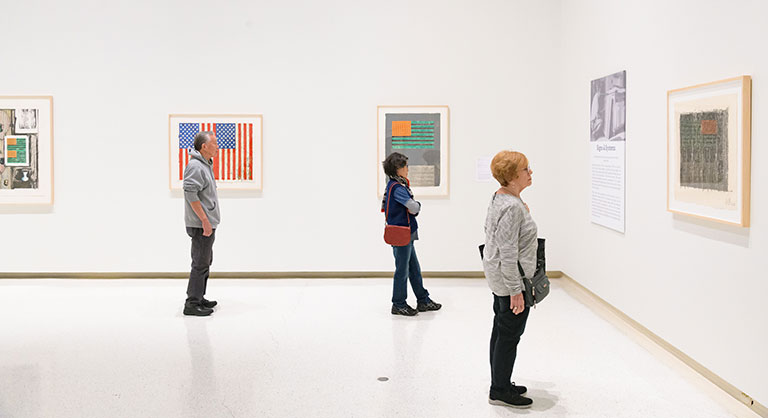
Jasper Johns exhibited in four Carnegie Internationals in the ‘50s and ‘60s, but the museum didn’t acquire any of the exhibited work. “He’s the one who got away from the Carnegie International,” says Eric Crosby.
All would go on to achieve success. Johns’ moment arrived thanks in no small part to a good night’s sleep. “I dreamed that I painted a large American flag,” he has recalled, “and the next morning I got up and I went out and bought the materials to begin it.” Flag (1954) effectively launched his career and now hangs in the Museum of Modern Art in New York.
“Sometimes I see it and then paint it. Other times I paint it and then see it. Both are impure situations, and I prefer neither.”
– Jasper Johns
The canvas was large at 5 feet wide and 3 1/2 feet tall. And it was literal in its view of the Stars and Stripes, yet not exactly. By using encaustic paint, which is hot wax mixed with color to give it a bumpy, thick, and smeared texture, Johns’ flag image became familiar and unfamiliar at the same time. It was incendiary, but was it really? He would go on to paint or draw more than three dozen versions, some white or gray, some doubled or tripled.
“Johns has always avoided any sort of engagement with politics or commentary of any social type,” Rothfuss says. “I would say that his work is more timeless than timely, but that doesn’t make it any less relevant.
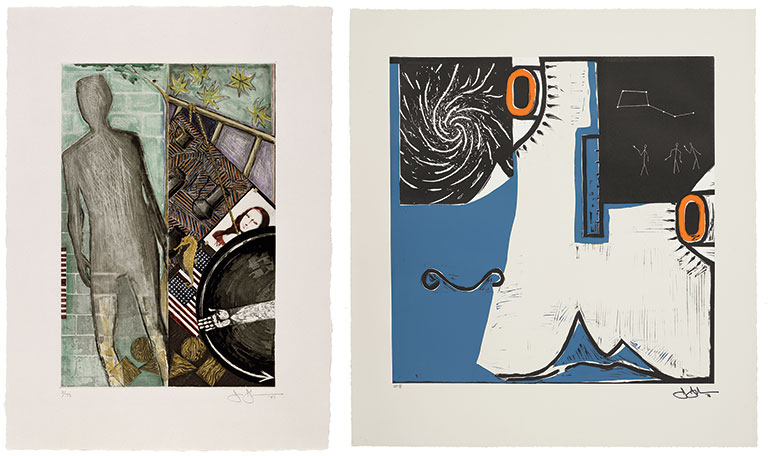
Jasper Johns, The Seasons (Summer), 1987, Collection Walker Art Center, Gift of Judy and Kenneth Dayton, 1988 © Jasper Johns and ULAE/VAGA at Artists Rights Society (ARS), NY, Published by Universal Limited Art Editions; Right: Untitled, 2016, Collection Walker Art Center, Gift of the artist, 2017 © Jasper Johns/VAGA at Artists Rights Society (ARS), NY
“He’s often been called an artist’s artist,” she continues, “meaning that his work can be deeply appreciated by other people engaged in the same endeavor. But that doesn’t mean he’s not accessible to the general viewer.”
In fact, Johns issues a standing invitation for the viewer to share in his thought process. “It’s always right there on the surface of the work,” Crosby says. “He’s inventing new connections between the visual and the linguistic, the recognizable and the abstract, printmaking and painting, the hand drawn and the found image. There are all these different, wonderful meanings one can make.
“It’s as much an art of possibilities as it is change.”
And the potential—for analysis and discussion, scrutiny and inquiry—is seemingly endless. Of course, Johns wouldn’t want it any other way.
“I have no ideas about what the paintings imply about the world,” Johns has said. “I don’t think that’s a painter’s business. He just paints paintings without a conscious reason.”
Crosby, for one, savors the ambiguity.
“There’s a kind of mystery involved in the unraveling of Johns’ motifs over the decades,” he says. “There’s something very human and rewarding about seeing the work over time.”
Major support for An Art of Changes: Jasper Johns Prints, 1960–2018 is provided by The Virginia Kaufman Fund, the James H. and Idamae B. Rich Art Exhibition Endowment, the Bernard S. & Barbara F. Mars Fund, and the Martin G. McGuinn Art Exhibition Fund.
Receive more stories in your email
Sign upTags:
Art
